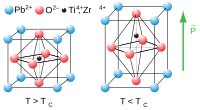Lead zirconate titanate
 |
|
| Names | |
|---|---|
|
IUPAC name
Lead zirconium titanate
|
|
| Other names
PZT
|
|
| Identifiers | |
|
12626-81-2 |
|
| 3D model (Jmol) | Interactive image |
| ECHA InfoCard | 100.032.467 |
| EC Number | 235-727-4 |
| PubChem | 159452 |
|
|
| Properties | |
| Pb[ZrxTi1-x]O3 (0≤x≤1) | |
| Molar mass | 303.065 to 346.4222 g/mol |
|
Except where otherwise noted, data are given for materials in their standard state (at 25 °C [77 °F], 100 kPa).
|
|
|
|
|
| Infobox references | |
Lead zirconate titanate is an intermetallic inorganic compound with the chemical formula Pb[ZrxTi1-x]O3 (0≤x≤1). Also called PZT, it is a ceramic perovskite material that shows a marked piezoelectric effect, meaning that the compound changes shape when an electric field is applied. It is used in a number of practical applications such as ultrasonic transducers and piezoelectric resonators. PZT is a white solid that is insoluble in all solvents.
Being piezoelectric, PZT develops a voltage (or potential difference) across two of its faces when compressed (useful for sensor applications), or physically changes shape when an external electric field is applied (useful for actuator applications). The dielectric constant of PZT can range from 300 to 3850, depending upon orientation and doping.
Being pyroelectric, this material develops a voltage difference across two of its faces under changing temperature conditions; consequently, PZT can be used as a heat sensor. PZT is also ferroelectric, which means it has a spontaneous electric polarization (electric dipole) that can be reversed in the presence of an electric field.
The material features an extremely large dielectric constant at the morphotropic phase boundary (MPB) near x = 0.52.
Some formulations are ohmic until at least 250 kV/cm (25 MV/m), after which current grows exponentially with field strength before reaching avalanche breakdown; but PZT exhibits time-dependent dielectric breakdown — breakdown may occur under constant-voltage stress after minutes to hours, depending on voltage and temperature, so its dielectric strength depends on the time scale over which it is measured. Other formulations have dielectric strengths measured in the 8–16 MV/m range.
...
Wikipedia
